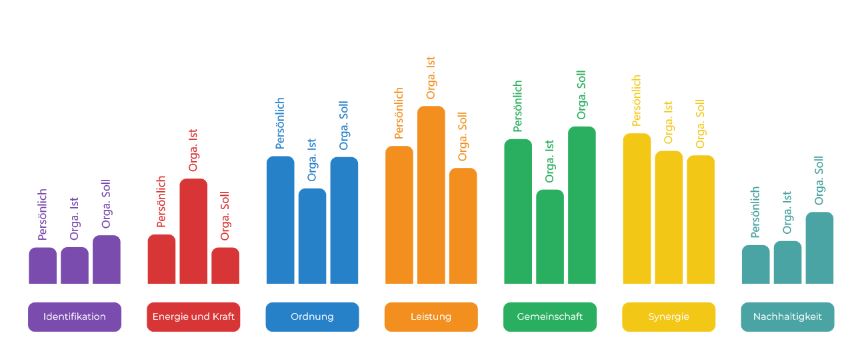
A “values-based transformation” is a 10-step process for describing and transforming corporate culture.
At berliner team, we understand “transformation” to be an emergent process with a profound impact.
In contrast to change processes, transformations in an organizational context are usually associated with a paradigm shift.
Basic assumptions, fundamental attitudes, approaches AND convictions are not only questioned, but literally unhinged.

When something happens or is done during a change (“We’re introducing the SAP CO module!”), the aim is then to achieve a target state.
Transformations, on the other hand, are far-reaching change processes that do not have a fixed and precisely defined goal in advance.
Transformations are therefore more comprehensive and fundamental than change projects usually are.
For example, the plan to successfully lead an organization or an industry onto a CO2-neutral path is not an event, but a process that we call transformation.
"Values determine what we respect and what we ostracize, they serve as an inner compass."
berliner team
So, like Christopher Columbus back then, we set sail without ever having seen our destination.
And without knowing the exact route there.
Sure, we have a rough idea of where we want to go.
But we don’t know beforehand whether it will be India or actually America where we end up.
Sailing off without a clear destination can undoubtedly be an exciting and enriching undertaking.
However, setting off without any basic orientation is a project that is doomed to failure.
This makes it all the more important to do everything in our power to ensure excellent navigation along the way.
The starting point and compass of the value-based transformation is the analysis of the values currently practiced and desired by employees in the company using the ValueParty value profile.
"We understand the value profile based on the value systems of the Graves Value System as the DNA of an organization's values."
berliner team
Knowing the values that are actually practiced and knowing which values are more or less desired or considered useful by the workforce in the future gives us a very concrete picture of the current and required corporate culture.
This is precisely where our tool – the ValueParty – comes into play.
An organization’s value profile provides a clear initial picture of which value systems are currently being practiced and which should become more important in the future:

You can find specific explanations of the value profile on the “App” page.
In fact, you give up some control when you set up and plan the values-based transformation with the entire team.
But what you gain is so much greater: a cultural change is only successful if it is accepted and implemented on a broad basis.
Developing a new, changed and contemporary culture means absorbing what is already there, namely the values of the many individuals and the culture that is still practised, and using these to develop something new together.
Cultural development by decree only works where people are seen as objects.
We urgently recommend developing a culture for the people in an organization with the people.
The first step in a value-based transformation is therefore to define how all employees can be brought on board.
Which communication formats are set up?
Which tools are used?
When will who be informed and how?
How do we embark on this transformation journey together?
Everyone is informed, you’re ready to go!
Now it’s time to create the value profile.
This is the analysis of the current situation and the starting point from which to describe the need for change and derive measures.
There are several ways to create the value profile:
Step 3 involves relating the value profile to the specific aspects of your team or corporate culture and deriving the change objectives from this in the next step.
In step 3, the characteristics of your corporate culture are worked through (e.g. processes, dealing with power, reward systems, etc.) and discourse formats on culture are set up.
The actual process of cultural work begins.
A mission statement or North Star is needed to make the value-based transformation comprehensible for everyone, to provide orientation as a community and to have something to refer to in everyday life.
This defines the direction of the change.
The findings of the third bar of the value profile, i.e. the bars that describe the culture the organization needs to master the challenges now and in the future, must be brought to the point and worked out as a target image that everyone can understand.
To this end, a mission statement is drawn up and discussed with colleagues.
A compass of values is also drawn up to help navigate potentially difficult situations in the future.
Step 5 is about creating a company-wide awareness of the mission statement and the desired culture.
The mission statement and its significance for the company are communicated clearly and unambiguously.
All employees know and understand the mission statement.
Dialogue formats such as cocktail workshops and retrospectives are set up and used to achieve this penetration.
The following steps 6-10 are no longer sequential, but take place in parallel and in an iterative process.
Overarching fields of action were identified in step 5.
Further fields of action can be derived from the value profile (step 2) (more on this under “App“).
These now need to be sorted and suitable development measures designed.
To do this, we use the agile method toolbox and rely on an iterative approach.
In our experience, it is easier to change a culture if you also do things differently.
At the same time, when introducing new formats, values and culture should be reflected upon and other behaviors should be consciously tried out.
In this sense, “being new” (values and identity) is not only a prerequisite for “thinking new” and “acting new”.
Acting anew” also influences “thinking anew” and “being anew”.
After several well-moderated retrospectives, participants suddenly feel encouraged to accept personal and direct feedback from colleagues and to address it themselves.
At berliner team, we call this the “seduction” of trial and error, also referred to by us as the “cunning of the transformation gurus”.
Direct communication to everyone, a communication infrastructure via media or platforms and external communication…
How can these elements of communication be structured and designed to make communication a success?
Answers such as the Bergfest, the appropriate communication structure and direct communication as a vehicle can be found in step 8.
Crises are part of change and are necessary to develop higher-level competencies.
As they can be very unpleasant and create resistance in the process of change, in step 9 we deal in detail with fully understanding the symptoms of the crises and resistance that occur.
Effective measures are then developed and established to counter resistance and to anticipate and sustainably resolve crises.
The key to ensuring the sustainability of cultural change is to understand that culture is not a one-off project, but an ongoing process that requires constant attention and care.
To this end, it is essential that responsibility for the culture is anchored in the company.
A good concept for this is the Transformation Office.
We take the necessary steps to establish a Transformation Office in step 10.



Entdecke Deine Sicht auf die Wertestruktur in Deiner Organisation und hole Dir jetzt Dein persönliches Werteprofil mit der ValueParty-App!
